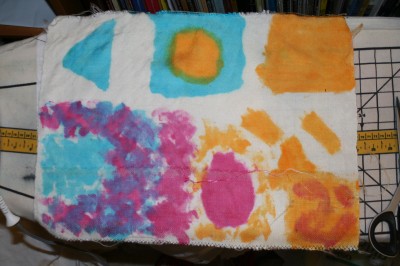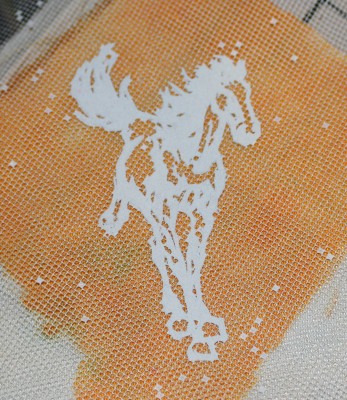Yesterday I cut some of my precious alpaca/tencel fabric off the loom, rushed it outside, and started the differential dyeing process. I was in a bit of a hurry because I was dyeing in one of the few dry moments in a week-long deluge of rain, and I wasn’t sure how long it would last. So instead of carefully planning out my experiments, I rapidly painted on a set of shapes and figures:

I let that react overnight, and rinsed it out this morning. Please click and zoom in on the photo to see how the patterns came out:

Happily, the tencel dyed beautifully while the alpaca stayed (mostly) white, so I am fairly confident that after applying the acid dyes I’ll get at least some interesting effects.
What next? I’m going to paint the fabric with acid dyes (thickened with sodium alginate, as I did with the fiber-reactive dyes), fix the dyes, and see what happens. Since I have (finally!) finished my stencils, I plan to try stenciling a running horse in the yellow section:

The stencils, by the way, are made according to Jane Dunnewold’s recommendation in Art Cloth: cut from two layers of fusible interfacing (fusible sides facing), which are then sandwiched with a piece of netting, fused together, coated with latex house paint, and gently ironed with a warm iron to set the paint. This renders it waterproof, at least in theory. We’ll see how well it actually works.
I am also hoping to get the silkscreens started this week, but that may take longer – the emulsion needs to be applied wet, then dried out in the dark – and as there are no dark spots inside the house and the garage is cold and damp (rain = high humidity), that may have to wait until the skies dry out. At least this weekend looks promising, weather-wise.
By and large I expect differential dyeing to be laborious, as many of the dye techniques I want to use involve dyeing twice – once for background and once for pattern. Multiplied by two different dye types, that comes out to four dye sessions for a single piece of fabric! But I am hoping it will be worth it in the end.
I am currently making a more organized list of dye techniques I plan to try, and will be tackling them this weekend. If it EVER stops raining!

Tien, this is fascinating. What are you doing to fix the dyes permanently? I am assuming you are adding sodium carbonate to the fiber reactive dye. Are you steaming everything to set the acid dyes?
I’m dyeing in two separate processes, once for fiber-reactive (with soda ash) and once with acid dyes (with citric acid). Long-term, I am planning to “batch” the acid dyes for a few days at room temperature, but for this sample, I baked it in the oven at 170 for about 2 hours, due primarily to my own lack of patience! 🙂
It will be great to see where you with this technique. How is your alpaca standing up to the soda ash?